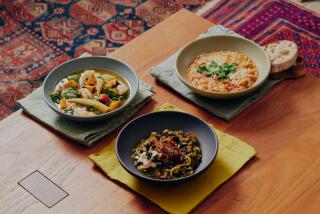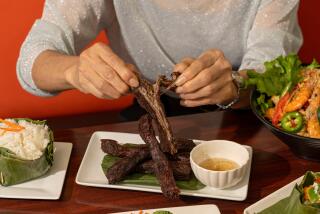The First New Year : When Peanut Butter was as prized as a 1,000-year-old egg
On Monday, Chinese will usher in the Year of the Rat. It was at the end of another Year of the Rat in 1972, that I experienced the elaborate preparations for my first Chinese New Year.
I had traveled to Taiwan at 19 to learn to speak Mandarin and to study Chinese cooking. For a young woman who had grown up in a New England town, the arrival of Chinese New Year in Taipei--when the Year of the Rat became the Year of the Ox--was an unforgettable event.
A month before the holiday, the first signs of the celebration appeared in the marketplace: mountainous piles of dried black mushrooms, oysters, abalone and other traditional New Yearâs delicacies. Clotheslines once laden with newly washed garments were suddenly heavy with strings of freshly made Chinese sausage.
In the home where I was staying, the family maid lost no time turning the house upside down in a frenzied bout of cleaning. Because the New Year demands a clean slate, all business affairs are tidied up and all accounts are settled before the holiday. My surrogate Chinese brothers and sister were measured for new outfits.
On the 23rd day of the 12th month of the lunar calendar, we smeared the lips of the papered image of the kitchen god that hung above the stove with honey and presented offerings of fruits and malt sugar. Then we burned the poster. This was done to ensure that when the kitchen god returned to heaven to report on our household, he would only utter sweet remarks and kind words about our family.
Because my surrogate Chinese family was quite prominent in Taiwan, we emptied a whole room for the expected onslaught of gifts. (It is the custom for relatives and business associates to shower their bosses and elders with gifts of food.)
I was amazed at the booty that arrived: huge bags stuffed with costly dried black mushrooms imported from Hong Kong, handsome flash-frozen tiger shrimp from Thailand, sumptuous 1,000-year-old eggs, dried sharkâs fin and birdâs nest arranged in see-through plastic boxes. There were tins of French chocolates and boxes of Japanese cakes. To my amazement, the most prized presents were gift boxes filled with cans of Del Monte fruit salad and peaches in syrup, Bumblebee tuna and jars of Skippy peanut butter.
My all-time favorite gift was a live chicken, which strutted about our backyard for several days before he was beheaded and served in a delicious red-cooked stew.
As the holiday neared, we began the preparations for the traditional dishes. Dumplings, the quintessential New Yearâs specialty, were among the first foods to be made.
Because the dumpling shape is likened to an ingot of silver or gold, it is believed to bring good fortune. We organized small groups to make multiple batches, lining them on trays for freezing. (On New Yearâs day they were thrown into a pot of boiling water and served within minutes.) As we stuffed and folded, we were all careful--as custom dictates--to talk only about good things so that good luck would be passed on with the dumplings.
My family liked dumplings stuffed with ground pork, minced cabbage and garlic chives, but others, who abstained from eating meat on the holiday, preferred vegetable fillings made with shredded carrots, black mushrooms and cabbage. Other popular stuffings were made with peanuts (eaten to assure long life), chestnuts (in hopes of having sons) and sugar and candied fruits (for a sweet life). Some families would hide things in their dumplings: coins (for prosperity), rings (in hopes of finding a husband) and pieces of noodle or string (for longevity).
Besides dumplings, countless other dishes are traditionally served at the New Yearâs Eve banquet. Platters filled with such costly foods as sharkâs fin, abalone, be^che-de-mer (sea cucumber) and birdâs nest are served in honor of the great occasion, and foods that symbolize or resemble auspicious things are popular. Clams, for instance, symbolize receptivity to good fortune, fried spring rolls resemble bars of gold and a whole fish symbolizes bounty. (Some families merely place wooden models of fish on their tables.)
Our family especially loved to prepare foods shaped or trimmed to rounds, resembling coins. My surrogate fatherâs favorite dish was scallops with snow peas in oyster sauce.
On the eve of the holiday, everyone stayed up to welcome the New Year. My Chinese brothers and sister could hardly wait for midnight, when we were presented with red envelopes containing money. We didnât gather around the clock counting down the seconds as my friends did on New Yearâs Eve in America, but we did wait expectantly to hear the roar of firecrackers signaling the official arrival of the holiday. (Firecrackers are also lighted to ward off evil and lazy spirits.) We then burned incense to welcome the returning gods from heaven and offered respects to departed relatives.
A new image of the kitchen god was posted over the stove, and the men and women separated to their respective mah-jongg games. I stayed with the children, cousins included, who played games and set up contests, placing bets with their New Yearâs loot. This was the only time gambling was allowed for the children.
After we had a brief rest, our last official act of New Yearâs Day was to go to Ximending square in downtown Taipei to see the dragon dance, a ceremony that originated more than 1,000 years ago. In ancient times, the dragon was the emblem of the Chinese emperor; it still symbolizes strength and goodness. The dragon--so it is believed--imparts to everyone the wish for prosperity, good luck and peace in the coming year.
As the banquet foods prophesied, the new year and subsequent years have been filled with auspicious events: I married and produced a son, as well as several cookbooks. And I have enjoyed many wonderful New Yearâs banquets. But I still think fondly of the first New Yearâs celebration in Taipei when the costliest Chinese delicacies paled in comparison to Skippy peanut butter and Bumblebee tuna.
* Simondsâ latest cookbook, âAsian Noodles: 75 Recipes to Twirl, Slurp and Savor,â will be published by William Morrow in November.
NORTHERN-STYLE DUMPLINGS
If garlic chives are unavailable, substitute 1 1/2 cups chopped leeks and 1 tablespoon minced garlic.
4 cups finely minced Chinese or Napa cabbage
1 teaspoon salt
1 pound ground pork butt
2 cups finely minced Chinese garlic chives
2 1/2 tablespoons soy sauce
2 tablespoons toasted sesame oil
1 1/2 tablespoons rice wine or sake
1 1/2 tablespoons minced ginger root
1 tablespoon cornstarch
50 dumpling or gyoza skins
Combine cabbage and salt in bowl and toss lightly to mix evenly. Let sit 30 minutes, then grab handfuls of cabbage and squeeze out as much water as possible. Place squeezed cabbage in bowl, add ground pork, minced chives, soy sauce, sesame oil, rice wine, ginger root and cornstarch. Stir vigorously in continuous direction to combine evenly.
Place 1 teaspoon cabbage mixture in center of dumpling skin and moisten edge with little water. Fold over to make half-moon shape. Use thumb and index finger to form small pleats along outside edge of the skin. With other hand, press opposite edges of skin together to seal. Inside edge should curl in semi-circle. Alternatively, you may just press opposite edges together to form half-moon shape. Arrange finished dumplings on baking sheet that has been dusted with cornstarch.
Cook half of dumplings in boiling water 5 minutes, stirring occasionally. Remove with handled strainer or slotted spoon and return water to boil. Repeat with remaining dumplings.
Dumplings can also be pan-fried in little oil until golden brown on both sides. Serve with soy sauce and smashed garlic or 1/3 cup soy sauce, 1 1/2 tablespoons Chinese black vinegar or Worcestershire sauce and 1 tablespoon finely shredded ginger root.
Makes 50 dumplings or 6 to 8 servings
Each of 6 servings, without dipping sauce, contains about:
365 calories; 1,030 mg sodium; 47 mg cholesterol; 19 grams fat; 35 grams carbohydrates; 15 grams protein; 0.45 gram fiber.
NEW YEARâS SCALLOPS IN OYSTER SAUCE
1 1/2 pounds sea scallops, rinsed lightly and drained
5 tablespoons rice wine or sake
3 tablespoons minced ginger root
1/2 teaspoon salt
1/2 cup chicken broth or water
5 tablespoons oyster sauce
2 1/2 tablespoons soy sauce
1 tablespoon sugar
1 teaspoon toasted sesame oil
1 tablespoon safflower or corn oil
3/4 pound fresh snow peas, ends snapped and veiny strings removed
2 tablespoons minced green onions, white part only
1 tablespoon minced green onion tops
Holding cleaver or chefâs knife parallel to cutting board, slice each scallop in half horizontally. Place scallop slices in bowl.
Add 3 tablespoons rice wine, 1 tablespoon minced ginger root and salt. Toss lightly and let marinate 20 minutes.
Combine chicken broth, oyster sauce, soy sauce, sugar and sesame oil in small bowl and set aside.
Poach scallops in simmering water until flesh turns white and opaque, about 1 minute. Remove with slotted spoon and drain.
Add 1/2 tablespoon safflower oil to wok over high heat. When oil is almost smoking, add snow peas and remaining 2 tablespoons rice wine and stir-fry until crisp-tender, about 1 1/2 minutes. Remove and distribute around outside of serving platter.
Add remaining 1/2 tablespoon safflower oil to wok and stir-fry 2 tablespoons green onions and remaining 2 tablespoons ginger root until fragrant, about 10 seconds. Add oyster sauce mixture and heat until boiling. Cook 2 to 3 minutes, until slightly thickened. Add cooked scallops and toss lightly with sauce. Spoon onto platter in center of snow peas. Sprinkle top with remaining minced green onion tops. Serve immediately.
Makes 6 servings.
Each serving contains about:
178 calories; 1,655 mg sodium; 30 mg cholesterol; 4 grams fat; 14 grams carbohydrates; 18 grams protein; 1.47 grams fiber.
MONGOLIAN BEEF FIREPOT
MONGOLIAN DIPPING SAUCE
3/4 cup soy sauce
3 1/2 tablespoons rice wine or sake
3 1/2 tablespoons Chinese black vinegar or Worcestershire sauce
2 tablespoons sugar
3 tablespoons minced green onions
2 tablespoons minced ginger root
2 tablespoons minced garlic
1 teaspoon hot chile paste
Combine soy sauce, rice wine, black vinegar, sugar, green onions, ginger root, garlic and chile paste in small bowl and mix well. Sauce will keep 1 week, refrigerated.
MONGOLIAN BEEF
1 1/2 tablespoons soy sauce
1/4 cup rice wine or sake
1 teaspoon toasted sesame oil
1 1/2 pounds top sirloin beef, cut into paper-thin slices
1 tablespoon safflower or corn oil
1 pound Chinese or Napa cabbage
5 cloves garlic, smashed
6 cups chicken broth
1 teaspoon salt
1 (1.8-ounce) package cellophane noodles (bean threads), softened in hot water to cover
1 1/2-pound square hard tofu, cut into 1/2-inch cubes
1 pound fresh shiitake, button or other wild mushroom, cleaned, stems trimmed
1/2 to 3/4 pound fresh spinach, cleaned and trimmed
Trim cabbage stems, separating leaves. Cut in half lengthwise, then cut in 2-inch squares.
Combine soy sauce, 1 tablespoon rice wine and sesame oil in bowl to make marinade. Add sliced beef and toss lightly.
Heat safflower oil in wok over high heat until very hot. Add harder cabbage stem sections and garlic and toss lightly over high heat 1 1/2 minutes. Add leafier sections of cabbage and toss about 1 minute until slightly tender.
Add remaining 3 tablespoons rice wine, chicken broth and salt and heat until boiling. Reduce heat to low and simmer, uncovered, about 20 minutes. Transfer soup to Mongolian firepot, electric wok or pot placed over portable burner or hot plate placed in center of table and keep at simmer.
Arrange beef, cellophane noodles, tofu, mushrooms, and spinach on plates or several platters and bring to table.
Place bowl of Mongolian Dipping Sauce at each place setting. Add tofu, mushrooms and cellophane noodles to broth and cook for several minutes. Each diner helps himself by dipping meat in simmering broth until cooked, then dipping meat in sauce. Diners can also eat tofu, mushrooms and lightly cooked spinach, dipping in broth. At last, each diner spoons broth and noodles into serving bowl to eat.
Makes 6 servings.
Each serving contains about:
782 calories; 3,767 mg sodium; 51 mg cholesterol; 26 grams fat; 93 grams carbohydrates; 54 grams protein; 7.65 grams fiber.
More to Read
Eat your way across L.A.
Get our weekly Tasting Notes newsletter for reviews, news and more.
You may occasionally receive promotional content from the Los Angeles Times.










